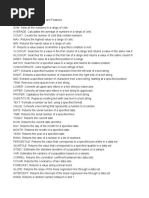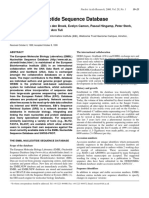BA Notes 2
Uploaded by
Charanvenkatesh GBA Notes 2
Uploaded by
Charanvenkatesh G1.
Analytics on spreadsheets:
Following are the high- level Analytical functions in excel.
Basic Functions Min, Max, Sum, Average, Count, Countif, CountA,
Descriptive Statistics Basic statistics like mean, median, mode, range, standard deviation,
and variance.
Pivot Tables Summarizes data and makes it easier to see patterns and trends.
Conditional Highlights data points based on specific criteria, making patterns
Formatting and outliers more visible.
Data Filtering Allows users to view specific subsets of data by setting criteria.
Charts and Graphs Charts and Graphs
*Note: We will learn about a lot of other techniques like Regression and Forecasting in coming chapters which
can be implemented in excel, however the above are the basic analytics in Excel.
Copy of Project Data
Analysis.xlsx
For Practice:
2. Excel functions for Database queries
Following are the excel functions for working with the data in database.
DSUM Adds the numbers in a field (column) of records in a database that match
conditions you specify.
DCOUNT Counts the cells that contain numbers in a field (column) of records in a
database that match the conditions you specify.
DCOUNTA Counts the non-blank cells in a field (column) of records in a database that
match the conditions you specify.
DGET Extracts a single value from a field (column) of a database that matches
the conditions you specify.
DAVERAGE Calculates the average of the numbers in a field (column) of records in a
database that match the conditions you specify.
DPRODUCT Multiplies the values in a field (column) of records in a database that
match the conditions you specify.
DMIN Returns the smallest number in a field (column) of records in a database
that match the conditions you specify.
DMAX Returns the largest number in a field (column) of records in a database
that match the conditions you specify.
DVAR Estimates the variance of a population based on a sample by using the
numbers in a field (column) of records in a database that match the
conditions you specify.
DSTDEV Estimates the standard deviation of a population based on a sample by
using the numbers in a field (column) of records in a database that match
the conditions you specify.
Ramaraju Poosapati Business Analytics For year 2024 1
3. Add-ons for Business Analytics.
VLOOKUP Searches for a value in the first column of a range and returns a
value in the same row from a specified column.
HLOOKUP Searches for a value in the first row of a range and returns a value in
the same column from a specified row.
INDEX Returns the value of a cell in a specified row and column of a range
MATCH Searches for a specified value in a range and returns the relative
position of that item.
LOOKUP Searches for a value in a one-row or one-column range and returns a
value in the same position from another one-row or one-column
range.
OFFSET Returns a reference to a range that is a specified number of rows
and columns from a cell or range of cells.
CHOOSE Returns a value from a list of values based on a specified index
number.
FILTER Filters a range of data based on criteria and returns the matching
records.
SUMIFS Adds the cells specified by a given set of conditions or criteria.
COUNTIFS Counts the number of cells that meet a set of multiple criteria.
4. Data Visualization
Data visualization refers to the graphical representation of information and data using visual elements
like charts, graphs, and maps. It Simplifies complex data to make it easier to understand, identify
patterns, trends, and outliers. It helps to enhances data comprehension and facilitates quick decision-
making.
Following are few commonly used visualization techniques.
Bar Charts: Compare different categories or track changes over time.
Line Graphs: Show trends over time or continuous data.
Pie Charts: Display proportions of a whole, useful for categorical data.
Histograms: Show the distribution of a dataset.
Scatter Plots: Identify relationships or correlations between variables.
Heatmaps: Represent data values with colour to show the intensity of data points.
Ramaraju Poosapati Business Analytics For year 2024 2
You might also like
- Excel Mastery With These Guided ProjectsNo ratings yetExcel Mastery With These Guided Projects66 pages
- The Most Simple Guide to Mastering ExcelNo ratings yetThe Most Simple Guide to Mastering Excel66 pages
- Excel Handbook The Ultimate MEWC Guide 35amqqNo ratings yetExcel Handbook The Ultimate MEWC Guide 35amqq70 pages
- Power BI DAX Functions Extended Cheatsheet 1712521727100% (1)Power BI DAX Functions Extended Cheatsheet 17125217278 pages
- Basic Excel Functions For Data Analysis 1691739185No ratings yetBasic Excel Functions For Data Analysis 16917391857 pages
- Analytics On Spreadsheets and Data Visualization: Prof M.ShashiNo ratings yetAnalytics On Spreadsheets and Data Visualization: Prof M.Shashi31 pages
- ANSWERS - End Sem Lab Excel for Data ScienceNo ratings yetANSWERS - End Sem Lab Excel for Data Science6 pages
- 10+ Simple Yet Powerful Excel Tricks For Data AnalysisNo ratings yet10+ Simple Yet Powerful Excel Tricks For Data Analysis8 pages
- Course 6 Week 4 Glossary - DA Terms and DefinitionsNo ratings yetCourse 6 Week 4 Glossary - DA Terms and Definitions20 pages
- Mastering DAX - Your Complete Guide to Functions & SyntaxNo ratings yetMastering DAX - Your Complete Guide to Functions & Syntax39 pages
- Ghaziabad Branch of Circ of Icai: Institute of Chartered Accountants of IndiaNo ratings yetGhaziabad Branch of Circ of Icai: Institute of Chartered Accountants of India49 pages
- 01 Glossary-Terms-And-Definitions Course 7 Week 3 Glossary DA Terms and DefinitionsNo ratings yet01 Glossary-Terms-And-Definitions Course 7 Week 3 Glossary DA Terms and Definitions22 pages
- UG B.A. History (English) UG B.A. English 108 53 History V Semester International Relations From 1914 AD Till Present 7030 1848No ratings yetUG B.A. History (English) UG B.A. English 108 53 History V Semester International Relations From 1914 AD Till Present 7030 1848236 pages
- An4635 Minimization of Power Consumption Using Lpuart For stm32 Microcontrollers StmicroelectronicsNo ratings yetAn4635 Minimization of Power Consumption Using Lpuart For stm32 Microcontrollers Stmicroelectronics52 pages
- 2022 Nissan Navara PRO 4X 4x4 2.5L Turbodiesel 7-Speed at 188 Bhp-Z0014366No ratings yet2022 Nissan Navara PRO 4X 4x4 2.5L Turbodiesel 7-Speed at 188 Bhp-Z001436611 pages
- Minors Travelling Abroad Consent To Travel2No ratings yetMinors Travelling Abroad Consent To Travel21 page
- Statistical Data SSC 1ST Annual 2024 Bise Multan100% (1)Statistical Data SSC 1ST Annual 2024 Bise Multan18 pages
- How To Do Opening & Closing of The Client-SCC4No ratings yetHow To Do Opening & Closing of The Client-SCC45 pages
- Documentupload - 254download Full Ebook of Organization Change Theory and Practice 6Th Edition W Warner Burke Online PDF All Chapter100% (8)Documentupload - 254download Full Ebook of Organization Change Theory and Practice 6Th Edition W Warner Burke Online PDF All Chapter69 pages
- English in Mind Starter Level Beginner Students Book Sample Pages PDFNo ratings yetEnglish in Mind Starter Level Beginner Students Book Sample Pages PDF5 pages
- Description: With Shining Stars Filling The Sky There Is Always Light To Guide You Which Also Depicts HopeNo ratings yetDescription: With Shining Stars Filling The Sky There Is Always Light To Guide You Which Also Depicts Hope2 pages
- ENGINEERING 3014 Engineering ChemistrySummerNo ratings yetENGINEERING 3014 Engineering ChemistrySummer2 pages

























































































